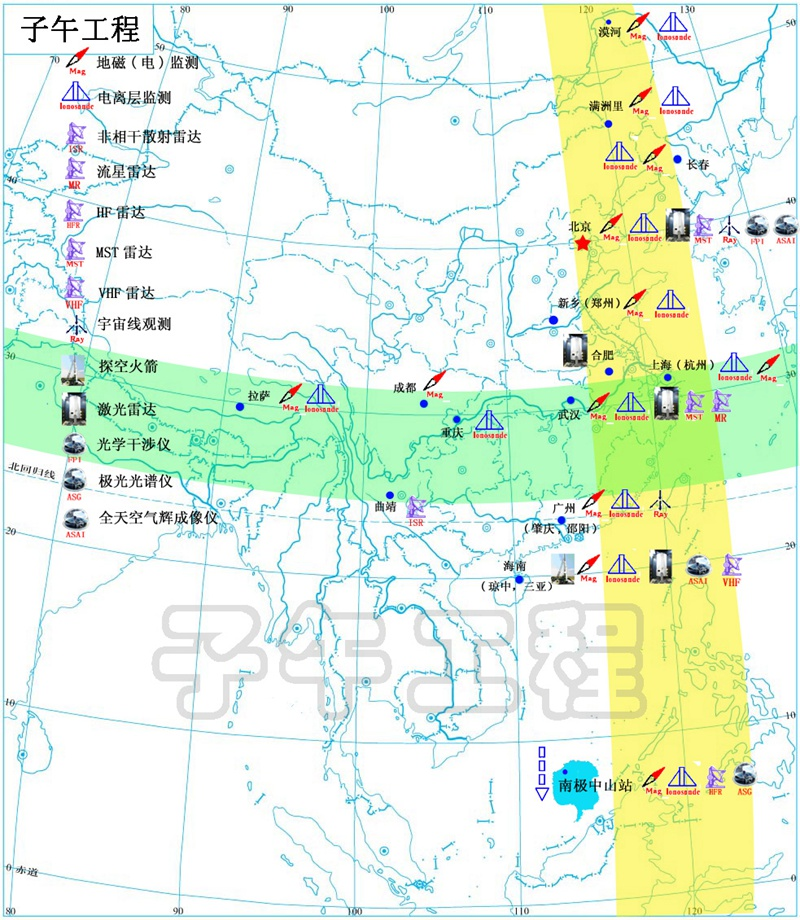Initially proposed in 1993 by Chinese scientists, the Chinese Meridian Project is a ground-based space environment monitoring facility funded by China’s National Development and Reform Commission as part of major scientific infrastructures. It is a joint effort of more than ten institutions and universities in China, led by the National Space Science Center (NSSC) of the Chinese Academy of Sciences, with participation from 15 institutions including Chinese Academy of Sciences, Ministry of Education, China Meteorological Administration, Ministry of Industry and Information Technology, China Earthquake Administration, Ministry of Natural Resources etc. In 2006, China’s National Development and Reform Commission officially approved the Meridian Project and its two-steps construction strategy.
The first phase of the project (2008-2012), with the full name of East-hemisphere Space Environment Ground-based Comprehensive Monitoring Chain, consists of 15 ground-based observatories located roughly along 120°E longitude and 30°N latitude. The first phase of the project mainly covers the eastern part of China. The instruments used can be grouped into 4 categories, namely geomagnetic (electric), radio wave, optical and sounding rockets, which are employed to continuously monitor the upper and middle atmosphere, ionosphere and magnetosphere from 20 or 30 kilometers to hundreds of kilometers above the Earth's surface to obtain the space environment parameters such as the magnetic field, electric field, atmospheric wind speed, density, temperature, composition, solar wind speed in the interplanetary space environment beyond 10 Earth radii. Its continuous operation in the past years led to more than 15 million scientific data files and it has provided services for thousands of users from home and abroad. The science team has published more than 300 peer-reviewed papers in prestigious journals such as GRL and JGR, obtained more than 60 patents, published 3 monographs, and has won 9 national and provincial awards.

Fig. Chinese Meridian Project-Phase I
In complement to the existing two monitoring chains deployed in the first phase, two more chains will be established along 100°E longitude and 40°N latitude respectively, forming a double-cross network configuration. Including the 15 stations from Phase I of the project, there will be 31 comprehensive stations in total. These are three instrument networks for monitoring geomagnetic field, mid-to-upper atmosphere, and ionosphere respectively. In addition to the three networks, four key regions are focused including the high, middle, low latitudes, and the third pole of Earth. In the second phase of the project, a series of instruments will be constructed to monitor activities on the solar atmosphere, such as sunspots on photosphere, solar flares on chromosphere, coronal mass ejections, and so on. These instruments comprise the cause and effect chain of the project. The above mentioned "one chain, three networks and four focus regions" will enable a 3D monitoring capability of the cause and effect of the space weather chain and multiple parameters in the solar terrestrial system, including the solar atmosphere, interplanetary space, magnetosphere, ionosphere, and middle-upper atmosphere.

Fig. Chinese Meridian Project-Phase II
The map shows the four focus regions of the second phase: polar regions, north of China, Tibetan plateau and low latitude region near Hainan island.





